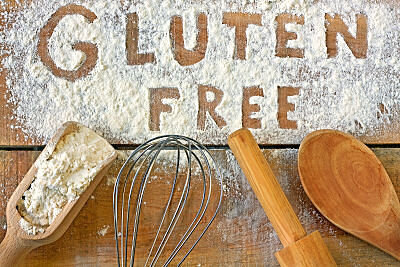A Guide to Eating Gluten-Free
Cutting gluten out of your diet may seem difficult and restrictive. Fortunately, there are many healthy and delicious foods that are naturally gluten-free. These include fruits, vegetables, meat and poultry, fish and seafood, dairy products, beans, legumes, and nuts.
Grains, Flours, and Starches
Many grains and starches are also naturally gluten-free, and products made with them (breads, pasta, crackers, etc.) can be incorporated into a gluten-free diet. However, grains and starches contain gluten and must be avoided by individuals with certain health conditions. Use the following table to help guide your eating and shopping choices while following a gluten-free food plan.
Gluten-Containing Grains, Flours, and Starches
Barley
Bulgar (bulgur)
Cereal binding
Chapatti flour (atta)
Couscous
Kinkel
Durum
Einkorn
Emmer
Farina
Farrow
Fu
Gluten, gluten flour
Graham flour
Kamut
Malt (malt beverages, extract, flavoring, syrup, vinegar, etc.)
Matzoh meal
Oats (oat bran, oat syrup)*
Orzo
Rye
Seitan (“wheat meat”)
Semolina
Spelt
Textured vegetable protein (typically contains gluten)
Triticale
Wheat, all varieties (bran, germ, starch)
Gluten-Free Grains, Flours Starches
Amaranth
Arrowroot
Bean flours (garbanzo, fava, Romano, etc.)
Buckwheat, buckwheat groats (kasha)
Cassava flour
Chia seeds
Corn (maize), cornmeal
Flax, flax meal
Hominy
Manioc flour
Mesquite flour
Millet
Montina flour
Nut flours and meals (almond, coconut, hazelnut, etc.)
Oats (gluten-free)*
Pea flour
Potato flour, potato starch
Quinoa
Rice (all), rice bran
Sago
Sorghum flour
Soy flour
Tapioca flour
Teff
Yucca
*Gluten-free oats have a similar structure to gluten-containing grains. Also, they may be contaminated with gluten-containing grains during processing. Because of these factors, gluten-free oats may cause negative symptoms in some patients. Those with celiac disease and gluten intolerance should use caution when consuming oats.
Gluten-Free Substitutes
Gluten-free alternatives to typical gluten-containing foods are now widely available in most grocery stores. This makes eating a gluten-free diet less of a hassle. But keep in mind that many products made with gluten-free alternatives include additives and fillers that help mimic the texture of gluten-containing products you’re used to eating. Rather than relying on gluten-free convenience foods, it is important to base your diet around naturally gluten-free foods like fruits, vegetables, and other foods listed above. © 2017 The Institute for Functional Medicine
The following foods may or may not be hidden sources of gluten. Read labels carefully when shopping, and ask restaurant staff to confirm that foods have not been dusted with flour or cross-contaminated in deep fryers.
Pizza, gluten-free (restaurants offering gluten-free crusts do not always keep gluten-free items separate from the rest of the kitchen)
Potato chips
Pre-seasoned meats
Processed lunch meats
Salad dressings
Self-basting poultry
Soup
Soy sauce
Starch or dextrin (in meat or poultry products)
Tater tots
Brown rice syrup (made with barley enzymes)
Candy, candy bars
Cheesecake filling
Eggs prepared in restaurants (sometimes include pancake batter)
Energy bars
French fries
Granola bars
Marinades
Meat substitutes (vegetarian burgers, vegetarian sausage, imitation bacon, imitation seafood, etc.)
Multi-grain or “artisan” tortillas and tortilla chips
Tips for Buying and Storing Gluten-Free Foods
Read labels. Remember that “wheat-free” is not the same thing as “gluten-free”. When in doubt, only purchase products with the certified gluten-free label.
Read ingredient lists for any processed or packaged foods you buy, especially any foods that are cream-based. Wheat is often used in these products as a thickener.
Many personal care products and nutritional supplements contain gluten. Be sure to choose brands that are gluten-free.
Many gluten-free breads and pastas are stored in the refrigerated or frozen sections in the grocery store.
If you can’t find gluten-free grains or products in your regular grocery store, try looking in a specialty or health food store.
Do not purchase gluten-free grains from the bulk section of the grocery store unless they are kept in a separate area from gluten-containing grains. The possibility for cross-contamination with gluten is much higher when gluten-containing and gluten-free grains are sold side by side.
If not everyone in your household follows a gluten-free diet, store all gluten-free products in a separate cabinet or a separate shelf. Keep gluten-free foods on the top shelves away from gluten-containing foods on the lower shelves. Use separate toasters and pans, if necessary. This will help you avoid cross contamination.
When purchasing beers, choose gluten-free brands that are made from gluten-free grains. Some gluten-free beers are made from gluten-containing grains that have been mechanically separated, and these beers may include up to 10 parts per million (10 ppm) of gluten per bottle. If gluten-free beer is not available, opt for cider, wine, or distilled spirits.



